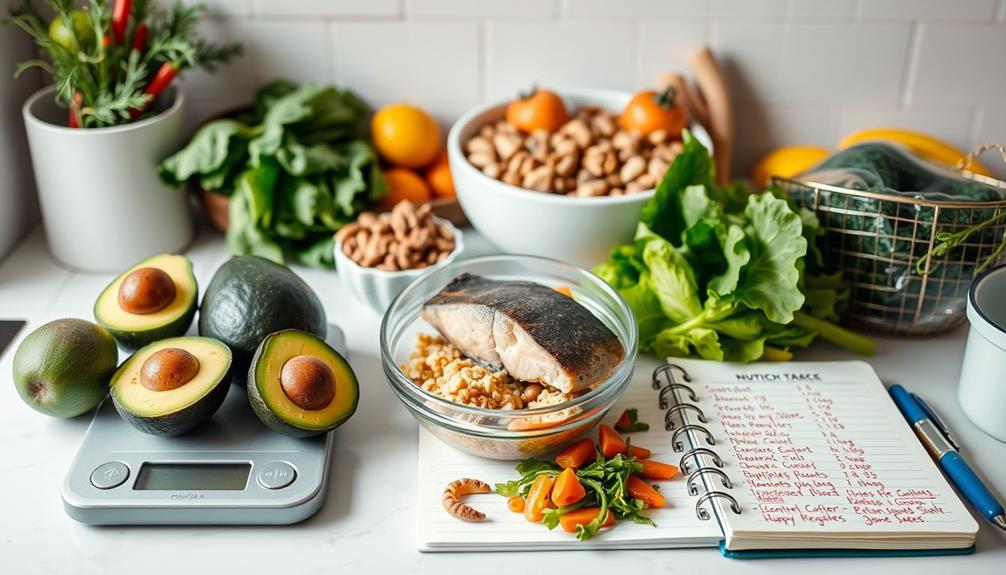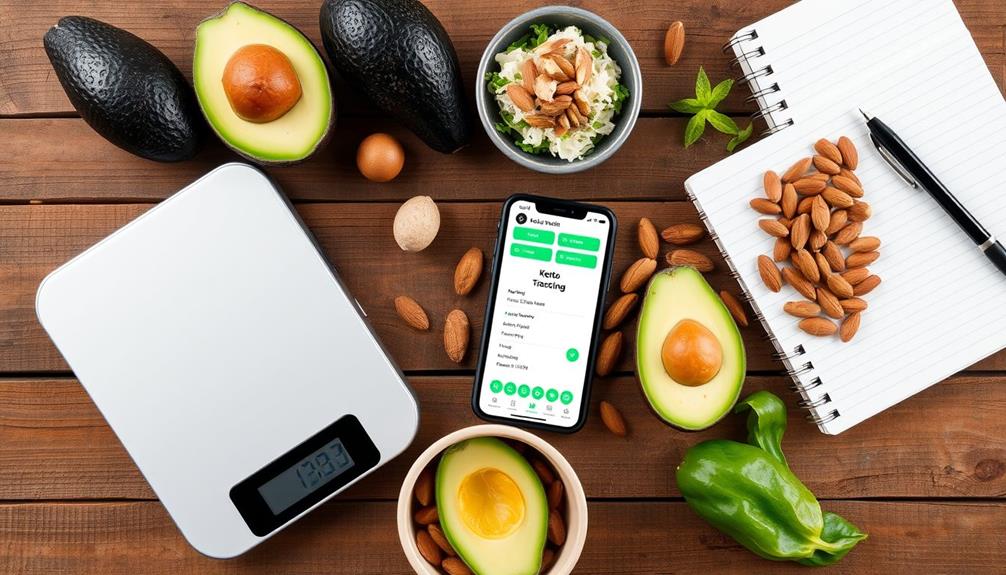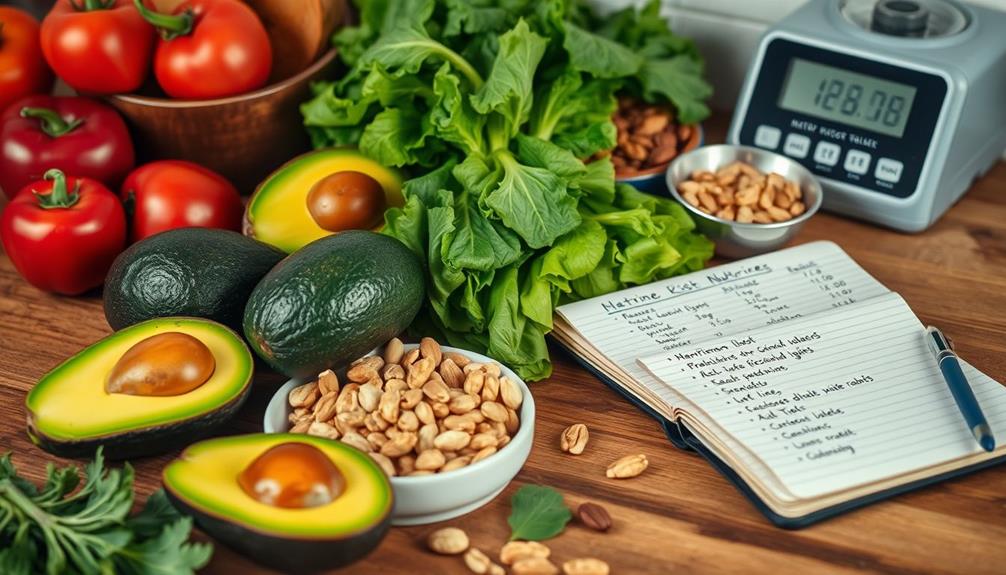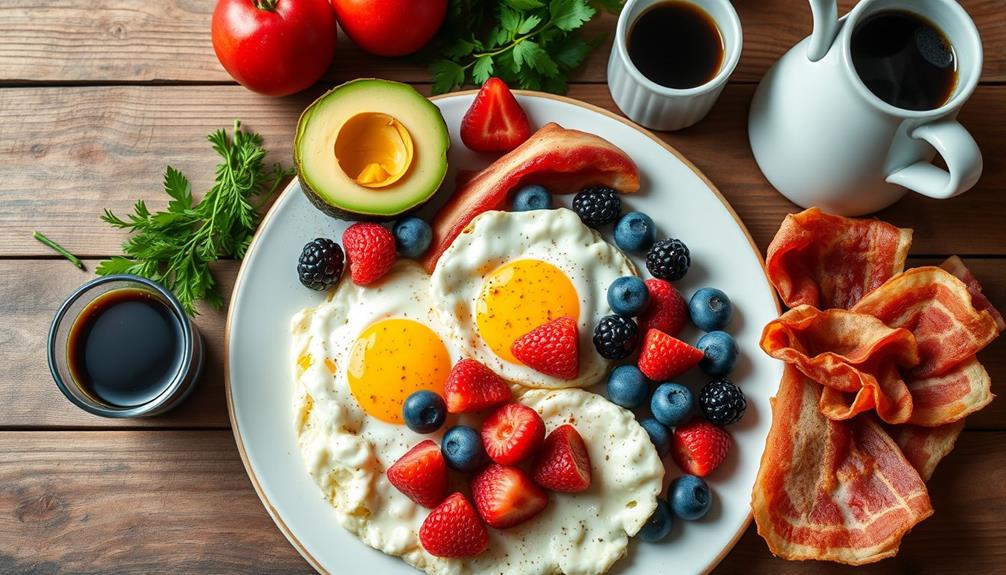Mastering the Keto diet means honing your skills in nutrient tracking, ensuring each bite counts. You'll need to focus on keeping your daily carb intake under 50 grams to maintain ketosis. Utilize food tracking apps like MyFitnessPal to simplify logging your macros and identify potential trigger foods. Meal planning is essential for variety while meeting your macro goals. Don't forget to track your electrolytes, as they play a significant role during fat adaptation. By engaging with the Keto community, you'll find support and motivation to keep you on track. There's much more to learn that could enhance your journey.
Key Takeaways
- Track key macronutrients—carbohydrates, fats, and protein—to maintain daily carb intake below 50 grams for ketosis.
- Utilize food tracking apps and macro calculators to simplify logging and tailor your nutrient intake to your goals.
- Meal planning ensures variety and helps meet macronutrient targets with healthy fats, proteins, and low-carb vegetables.
- Monitor electrolytes like sodium, potassium, and magnesium to counterbalance their increased excretion during fat adaptation.
- Engage with the Keto community for support, encouragement, and shared insights to enhance your nutrient tracking journey.
Understanding the Keto Diet

The Keto diet is a powerful low-carb approach designed to help you lose weight and enhance your overall health. By markedly reducing your carbohydrate intake to about 20-50 grams of net carbs daily, your body enters a state called ketosis, where it burns fat for energy instead of glucose.
This shift not only aids in weight loss but also supports diabetes management and provides sustained energy. You'll focus on consuming healthy fats and adequate protein, ensuring your meals are nutrient-dense.
Incorporating foods like avocados, nuts, and fatty fish can maximize your nutrient intake while keeping you satisfied.
With accessible meal plans and recipes, the Keto diet offers a structured way to improve your health and achieve your weight loss goals.
Nutrient Tracking Fundamentals

Tracking your nutrients is critical for success on the Keto diet. You'll want to focus on key macronutrients: carbohydrates, fats, and protein. Keep your daily carb intake below 50 grams to stay in ketosis.
Use macro calculators and food tracking apps to monitor your intake effectively. Barcode scanners in these apps can simplify logging packaged foods.
Additionally, don't overlook electrolytes; track sodium, potassium, and magnesium, as your body may excrete more during fat adaptation. Regularly replenishing these electrolytes is crucial for your overall health.
Importance of Nutrient Tracking

Maintaining a keen awareness of your nutrient intake can greatly enhance your Keto journey. When you track your macros—carbohydrates, proteins, and fats—you make informed decisions that align with your goals.
This awareness helps you stay within the vital carb limits to maintain ketosis, ensuring your body efficiently burns fat for fuel. Additionally, monitoring your nutrient intake allows you to identify potential trigger foods that could derail your progress or cause cravings.
Accountability increases as you visualize your progress, empowering you to stick to your plan. Engaging with community resources can provide encouragement and insights, making your Keto experience more enjoyable and sustainable.
Ultimately, effective nutrient tracking is essential for achieving lasting success on your Keto diet. By monitoring your nutrient intake and staying within your daily macros, you can ensure that your body stays in a state of ketosis, leading to sustained weight loss and improved overall health. Additionally, mastering glycemic index can help you make more informed choices about the types of foods you consume, ultimately supporting your Keto diet goals. Understanding how different foods affect your blood sugar levels can empower you to make smarter, more sustainable choices for long-term success.
Effective Tracking Tools

Frequently utilizing effective tracking tools can greatly simplify your Keto journey. By keeping a close eye on your macronutrient intake, you'll be more likely to stay in ketosis and achieve your health goals.
Here are some tools you might find helpful:
- Food Tracking Apps: Use apps like MyFitnessPal or Cronometer for easy logging and macronutrient calculations.
- Macro Calculators: Online calculators help you determine your ideal macronutrient ratios based on your goals.
- Food Journals: A simple notebook can help you track meals, feelings, and progress over time.
- Barcode Scanners: Many apps include barcode scanners, making it quick to log packaged foods accurately.
With these tools, you'll gain insights that can enhance your dietary choices and keep you accountable on your Keto path.
Strategies for Nutrient Management

Effective nutrient management is essential for successfully steering through the Keto diet and achieving your health goals.
Start by accurately calculating your macronutrients based on your individual needs. Customize your intake to fit your preferences and objectives.
Meal planning plays a vital role; make a variety of recipes that include healthy fats, proteins, and low-carb vegetables to keep things interesting.
Don't forget to log your water intake and exercise as well; this gives you a fuller picture of your overall health progress.
Remember, staying hydrated and active complements your dietary efforts, enhancing your results.
Nutrient Density Explained

Nutrient density is essential for anyone on a Keto diet, as it focuses on maximizing the nutritional value of every calorie consumed. By choosing foods rich in vitamins, minerals, and antioxidants, you can better support your health while staying within your macro limits.
Here are some key points to contemplate:
- Nutrient-dense foods help boost energy levels and support overall well-being.
- They play a role in weight management by providing satiety without excess calories.
- High nutrient density reduces the risk of chronic diseases.
- Prioritizing whole, unprocessed foods enhances your nutrient intake.
Incorporating nutrient-dense options like avocados, leafy greens, and fatty fish into your meals guarantees you're fueling your body effectively while enjoying the benefits of the Keto lifestyle.
Enhancing Your Keto Journey

Enhancing your Keto journey involves integrating practical strategies that make the shift smoother and more enjoyable.
Start by planning your meals to guarantee you're hitting your macro goals while keeping variety alive. Experiment with diverse recipes that incorporate healthy fats, proteins, and low-carb veggies.
Don't overlook hydration; drinking plenty of water supports your overall health and energy levels. Additionally, track your nutrient intake using apps or journals to stay accountable.
Engage with the Keto community for support and shared experiences, which can motivate you on tough days.
Frequently Asked Questions
What Are the Common Mistakes Beginners Make on the Keto Diet?
When starting the keto diet, you might underestimate carb intake, neglect healthy fats, or skip meal planning. Not tracking nutrients could lead to imbalances, making it harder to maintain ketosis and reach your health goals.
How Can I Deal With Keto Flu Symptoms Effectively?
To tackle keto flu symptoms, stay hydrated, increase your electrolyte intake, and eat nutrient-dense foods. Rest and gradually adapt your carb intake to help your body adjust smoothly to the dietary change.
Are There Any Specific Foods to Avoid While on Keto?
While on keto, avoid high-carb foods like bread, pasta, sugary snacks, and starchy vegetables. These can disrupt ketosis and hinder your progress. Focus on nutrient-dense options instead to maintain energy and health.
Can I Drink Alcohol on a Keto Diet?
Yes, you can drink alcohol on a keto diet, but choose low-carb options like dry wine or spirits mixed with zero-calorie mixers. Just remember to monitor your intake to stay within your carb limits.
How Does the Keto Diet Affect Mental Clarity and Focus?
The Keto diet can enhance your mental clarity and focus by providing a steady energy source through ketones. You'll likely experience reduced brain fog as your body adapts to burning fat for fuel.
Conclusion
In mastering the Keto diet, tracking your nutrients isn't just a theory—it's a game-changer. When you actively monitor your macronutrients, you gain insight into what fuels your body best. You'll discover that understanding your food choices leads to better health, weight management, and increased energy. So, embrace the power of nutrient tracking; it's not just about numbers, but about crafting a lifestyle that truly supports your goals. Commit to this practice, and watch your Keto journey thrive! Understanding your macronutrient intake is one of the keto diet secrets that can help you achieve greater success. By keeping track of your protein, fat, and carbohydrate consumption, you can maintain the optimal state of ketosis, where your body burns fat for fuel. Additionally, nutrient tracking allows you to make informed choices about the types of foods you consume, ensuring that you stay within your daily carb limit and avoid any hidden sugars. Ultimately, making nutrient tracking a regular part of your routine will empower you to take control of your health and well-being on the Keto diet.









